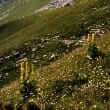Background
- Gentiana lutea is known for its bitter root. It has been used for hundreds of years for the digestive system. Supposedly, the action of gentian begins when it is absorbed by the membranes of the mouth. Particles in gentian stimulate the taste buds, causing an increase in saliva, gastric juice, and bile secretion.
- Available human studies for the traditional uses of gentian are currently lacking. Although gentian has been used traditionally with relative safety, poisoning has been reported with homemade gentian wine contaminated with white hellebore.
References
- Aberham, A., Schwaiger, S., Stuppner, H., and Ganzera, M. Quantitative analysis of iridoids, secoiridoids, xanthones and xanthone glycosides in Gentiana lutea L. roots by RP-HPLC and LC-MS. J Pharm Biomed.Anal 11-5-2007;45(3):437-442. View Abstract
- Amin, A. Ketoconazole-induced testicular damage in rats reduced by Gentiana extract. Exp Toxicol Pathol. 2008;59(6):377-384. View Abstract
- Chen, L., Liu, J. C., Zhang, X. N., Guo, Y. Y., Xu, Z. H., Cao, W., Sun, X. L., Sun, W. J., and Zhao, M. G. Down-regulation of NR2B receptors partially contributes to analgesic effects of Gentiopicroside in persistent inflammatory pain. Neuropharmacology 2008;54(8):1175-1181. View Abstract
- Citova, I., Ganzera, M., Stuppner, H., and Solich, P. Determination of gentisin, isogentisin, and amarogentin in Gentiana lutea L. by capillary electrophoresis. J Sep.Sci 2008;31(1):195-200. View Abstract
- Garnier, R., Carlier, P., Hoffelt, J., and Savidan, A. [Acute dietary poisoning by white hellebore (Veratrum album L.). Clinical and analytical data. A propos of 5 cases]. Ann.Med Interne (Paris) 1985;136(2):125-128. View Abstract
- Haraguchi, H., Tanaka, Y., Kabbash, A., Fujioka, T., Ishizu, T., and Yagi, A. Monoamine oxidase inhibitors from Gentiana lutea. Phytochemistry 2004;65(15):2255-2260. View Abstract
- Hayashi, T. and Yamagishi, T. Two xanthone glycosides from Gentiana lutea. Phytochemistry 1988;27:3696-3699.
- Mathew, A., Taranalli, A. D., and Torgal, S. S. Evaluation of anti-inflammatory and wound healing activity of Gentiana lutea rhizome extract in animals. Pharm.Biol. 2004;42:8-12.
- Ozturk, N., Baser, K. H., Aydin, S., Ozturk, Y., and Calis, I. Effects of Gentiana lutea ssp. symphyandra on the central nervous system in mice. Phytother Res 2002;16(7):627-631. View Abstract
- Schmieder, A., Schwaiger, S., Csordas, A., Backovic, A., Messner, B., Wick, G., Stuppner, H., and Bernhard, D. Isogentisin--a novel compound for the prevention of smoking-caused endothelial injury. Atherosclerosis 2007;194(2):317-325. View Abstract
- Szucs, Z., Danos, B., and Nyiredy, S. Comparative analysis of the underground parts of Gentiana species by HPLC with diode-array and mass spectrometric detection. Chromatographia 2002;56:S19.
- Toriumi, Y., Kakuda, R., Kikuchi, M., Yaoita, Y., and Kikuchi, M. New triterpenoids from Gentiana lutea. Chem Pharm Bull.(Tokyo) 2003;51(1):89-91. View Abstract
- VanHaelen, M. and VanHaelen-Fastre, R. Quantitative determination of biologically active constituents in medicinal plant crude extracts by thin-layer chromatography-densitometry. I. Aesculus hippocastaneum L., Arctostaphylos uva-ursi Spreng., Fraxinus excelsior L., Gentiana lutea L., Glyccyrhiza glabra L., Hamamelis virginiana L., Hypericum perforatum L., Olea europea L., Salix alba L., and Silybum marianum Gaertn. J Chromatogr 1983;281:263-271.
- Wang, C. H., Cheng, X. M., Bligh, S. W., White, K. N., Branford-White, C. J., and Wang, Z. T. Pharmacokinetics and bioavailability of gentiopicroside from decoctions of Gentianae and Longdan Xiegan Tang after oral administration in rats--comparison with gentiopicroside alone. J Pharm Biomed.Anal 9-3-2007;44(5):1113-1117. View Abstract
- Wang, C. H., Wang, Z. T., Bligh, S. W., White, K. N., and White, C. J. Pharmacokinetics and tissue distribution of gentiopicroside following oral and intravenous administration in mice. Eur J Drug Metab Pharmacokinet. 2004;29(3):199-203. View Abstract







